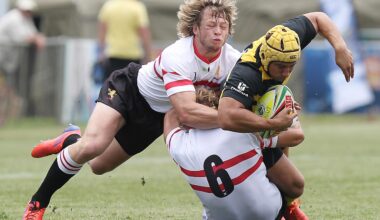Influence of Clothing and Gear on Heat Acclimation Effectiveness
Heat acclimation is a vital process for athletes to enhance their performance in hot conditions. The type of clothing and gear athletes wear plays a critical role in this adaptation. Choosing appropriate materials can promote thermoregulation while minimizing heat stress. For instance, lightweight and breathable fabrics are essential for facilitating airflow and moisture management. Athletes should consider wearing garments made from synthetic fibers, which are often engineered to wick away sweat efficiently. Cotton, though comfortable, may retain moisture, potentially leading to overheating. Moreover, the color of athletic apparel matters significantly; lighter colors reflect sunlight, which can help maintain a cooler body temperature compared to dark colors. Additionally, the fit is crucial; loose-fitting apparel allows better airflow while tight-fitting gear can hinder thermal regulation. Accessories such as hats and visors can further protect against sun exposure and heat buildup. Furthermore, specialized gear like cooling vests can enhance heat acclimation by lowering core temperature. Therefore, understanding how clothing impacts heat acclimation is essential for optimizing athletic performance and ensuring safety during intense training in hot climates.
In addition to clothing, hydration strategies are crucial in achieving heat acclimation effectively. Staying properly hydrated helps maintain optimal physiological functions associated with performance during heat stress. Athletes should prioritize drinking fluids before, during, and after exercise to replenish lost electrolytes. Sports drinks containing sodium, potassium, and other electrolytes can help augment the rehydration process, particularly during prolonged activities. Moreover, the timing of fluid intake significantly affects hydration levels; athletes may benefit from drinking small amounts consistently instead of consuming large volumes infrequently. Research indicates that pre-cooling techniques increase performance in hot environments, and proper hydration contributes to these methods. For instance, consuming cold beverages before exercise can lower core body temperature, which can aid in heat acclimation. Furthermore, athletes should monitor their hydration status by assessing urine color as a practical guide—light-colored urine indicates adequate hydration, while darker shades signal the need for more fluids. Ultimately, effective hydration, combined with proper clothing and gear, is essential for athletes seeking to maximize their heat acclimation, allowing them to perform at their best while enduring challenging conditions.
Environmental Factors Influencing Heat Acclimation
Heat acclimation is not solely dependent on clothing and gear; environmental factors significantly impact this adaptation process. Humidity plays a crucial role in determining how effectively heat is dissipated from the body through sweat evaporation. High humidity levels can hinder evaporation, leading to an increased risk of heat-related illnesses in athletes. Thus, training in varying humidity levels is essential for athletes aiming to adapt robustly to heat stress. Additionally, the duration and intensity of exposure to heat also influence the acclimation process. Gradual exposure, typically through systematic training schedules, enhances adaptability. Athletes should focus on increasing exercise duration in heat gradually while monitoring their response to the conditions. Moreover, factors such as wind can aid cooling; windy conditions can enhance evaporative cooling and mitigate heat stress. Additionally, acclimatization depends on individual differences such as age, genetics, and prior experience with heat training. Therefore, coaches and athletes should consider both environmental conditions and individual characteristics to determine the most effective acclimation protocols tailored to specific needs and scenarios in athletics.
Technical advancements in athletic gear are revolutionizing how athletes approach heat acclimation. Wearable technology, such as smart clothing and temperature sensors, provides real-time feedback on body temperature and sweat rates. This data allows athletes to make informed decisions regarding their performance and hydration needs during training. For instance, smart fabrics contain embedded sensors that monitor physiological responses to heat, providing valuable insights into individual acclimation progress. Additionally, innovative cooling technologies, such as phase change materials, are being integrated into athletic wear to actively regulate body temperature. These materials absorb, store, and release heat, keeping athletes cool even in extreme conditions. Moreover, advancements in insulation and moisture-wicking fabric technology create a balance between protection from the elements and breathability. Athletes are encouraged to explore options in gear that utilize these advanced materials to optimize their performance. Furthermore, efficient packaging and design contribute to making heat-acclimating gear not only functional but also user-friendly. As these technologies continue to evolve, the potential for improving athletic performance through better heat acclimation strategies will only grow, benefiting athletes competing in hot environments.
The Role of Adaptation Protocols
Effective heat acclimation involves well-structured adaptation protocols that incorporate both clothing choices and training strategies. These protocols emphasize slowly exposing athletes to heat conditions to allow the body to adjust over time. A typical acclimation plan may include sessions of gradually increasing intensity and duration while monitoring physiological responses such as heart rate and core temperature. During acclimation, athletes should wear their chosen training gear to understand how it affects performance in heat. Additionally, a standard recommendation is to engage in repeated exercise bouts in hot conditions over a span of 10 to 14 days, simulating competition scenarios. Careful attention to hydration strategies during these sessions is equally critical. Coaches should promote frequent breaks and provide guidance on rehydration, ensuring athletes can replenish electrolytes lost through sweat. Furthermore, incorporating rest days between intense heat exposure allows for recovery and adaptation. Exercises performed in less demanding heat may also help maintain conditioning while facilitating recovery. Thus, a systematic approach to adaptation protocols, including compatible clothing and hydration, is paramount for athletes striving to enhance their performance under demanding heat conditions.
Nutritional strategies also intertwine with heat acclimation to optimize athletic performance. A well-balanced diet equipped with essential nutrients supports overall health and physical endurance, crucial for acclimation success. Focusing on hydration through fluid-rich foods can enhance rehydration. Foods such as cucumbers, watermelon, and oranges offer hydration benefits alongside vitamins and minerals. Consuming adequate carbohydrates fuels energy during workouts, while protein promotes muscle repair. Electrolyte replenishment becomes even more critical during heat exposure, making mineral-rich foods an integral component. Athletes should prioritize meals rich in sodium and potassium to offset losses due to perspiration. Additionally, understanding meal timing in relation to workouts can maximize performance outcomes. Pre-exercise nutrition should focus on easily digestible carbohydrates to minimize gastrointestinal distress during intense training. Incorporating recovery meals post-exercise ensures a swift return to optimal energy levels. Alongside these dietary considerations, athletes are encouraged to experiment with their nutrition to find what aligns best with their individual preferences and physical responses to training in heat. In conclusion, nutrition, when combined with appropriate clothing and hydration strategies, plays a pivotal role in successful heat acclimation.
Conclusion and Future Directions
In sum, the interplay between clothing, gear, hydration, and overall heat acclimation effectiveness is complex yet crucial for athletes. Improved understanding of these factors is essential in developing strategies to enhance performance, particularly in hot conditions. Investments in advanced clothing technology and gear can lead to significant performance gains, whereas assessed adaptation protocols can yield customized approaches to heat acclimation. Moreover, ongoing research is vital to continuously optimize these strategies further. Future innovations may see the integration of artificial intelligence in personalizing acclimation protocols, considering unique physiological needs of athletes. Furthermore, the impact of nutrition as an influential element in heat acclimation deserves continued exploration. By emphasizing interdisciplinary collaborations between sports science, nutrition, and apparel engineering, athletes can better navigate the demands imposed by hot environments. Ultimately, prioritizing an integrated approach will allow athletes not only to achieve successful heat acclimation but also break performance barriers, ensuring safety and health while pursuing their sporting ambitions. The journey toward maximizing athletic performance in heat is ongoing, and the lessons learned today shape the future of sports in demanding conditions.


